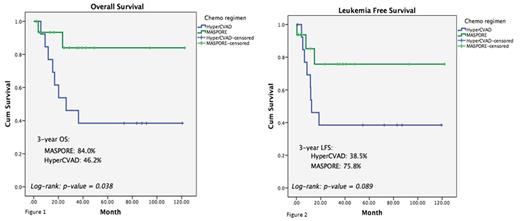Abstract
Background:
Pediatric acute lymphoblastic leukemia (ALL) have excellent overall survival (OS) compared to adult ALL even in the young adult group. The difference in OS was thought to be due to the difference in treatment protocol with the pediatric-inspired protocol being more intensive and with minimal residual disease (MRD) driven. Strong data has emerged over the past decade from different ALL study groups from Europe and North America to support the use of pediatric-inspired protocol for young adult up to age 30-40 years.
HyperCVAD protocol, designed by MD Anderson group in early 90s, has been our standard treatment for adult ALL including young adult since year 2000. Over the past decade, a locally designed pediatric-inspired and MRD driven protocol - known as MASPORE Protocol was used with increasing frequency for those age 30 years and below. MASPORE protocol has higher cumulative dose of vincristine and methotrexate, and use of L-Asparaginase compared to HyperCVAD.
In this retrospective study, we aimed to evaluate the safety, tolerability and efficacy of MASPORE protocol in relation to the standard adult ALL protocol - HyperCVAD in young adult aged 18-30 years who were diagnosed with Philadelphia-negative (Ph-) ALL.
Method:
Patients aged 18 to 30 years old with Ph- ALL who had received HyperCVAD or MASPORE regimen were retrospectively identified via our institution database. Clinical data, toxicity profile, and treatment outcome were collected, compared and analyzed.
High risk disease was defined as high white blood cell (WBC) (>30x109/L for B-ALL, and >100x109/L for T-ALL), failure to achieve complete remission (CR) after induction, failure to achieve MRD target at 4 weeks and 8 weeks (in MASPORE group), hypodiploidy, t(9;22), t(4;11) and other MLL-gene rearrangement. An intensified chemotherapy regimen would be given to those high-risk disease in MASPORE regimen, while HyperCVAD regimen has a fixed intensity irrespective of risk.
Results:
A total of 30 consecutive Ph- ALL patients aged between 18 to 30 years old who were treated with HyperCVAD or MASPORE protocol were included in the analysis. 16 were treated with MASPORE protocol while 14 were treated with HyperCVAD protocol. The median age was 22 years old (Range: 18 - 29 years old). Median follow-up for MASPORE was 37.0 months and HyperCVAD was 85.0 months. HyperCVAD-treated patients were mainly from year 2004 to 2011, while more than 80% of MASPORE patients were treated after year 2013.
18 patients had B-ALL, 11 with T-ALL and 1 with mixed phenotypes. 2 patients (1 in each group) had high cytogenetic risk. Median WBC was 14.1 (range: 1.9-287) and 10.1 (range: 1.2-242) for HyperCVAD and MASPORE respectively.
All patients achieved CR at the end of induction with no early death (within 60 days of induction). Overall relapse rate was 33.3% with lower relapse rate observed in in MASPORE (18.8%) compared to 50.0% in HyperCVAD. (p-value: 0.07). 4 in HyperCVAD and 3 in MASPORE received allo-SCT subsequently.
Median OS in MASPORE was not reached. Median OS for HyperCVAD was 26.3 months (95% CI: 3.6-49.1 months). Overall survival at 3 years were 84.0% and 46.2% in the MASPORE and HyperCVAD, respectively, p=0.038 (Figure 1).
Median Leukemia Free Survival (LFS) in MASPORE was not reached. Median LFS in HyperCVAD was 12.5 months (95% CI: 4.2-20.8 months). LFS at 3 years were 75.8% and 38.5% in the MASPORE and HyperCVAD respectively, p=0.089 (Figure 2).
6 patients in MASPORE had thrombotic events (3 with cerebral venous thrombosis and 3 with deep vein thrombosis (DVT)) while only 1 patient had DVT in HyperCVAD group. 11 patients in MASPORE group had at least 1 episode of grade 3 or more transaminitis, compared to 3 patients in HyperCVAD. 7 patients in HyperCVAD group had at least one episode of bacteremia during the course of treatment compared to 4 patients in the MASPORE group. Two treatment-related death were observed, both from HyperCVAD group.
Conclusions
MASPORE protocol was well tolerated albeit higher rate of thrombotic events and transaminitis which most likely related to L-asparaginase, but with lower incidence of bacteremia and treatment related death. It showed a superior overall survival compared to HyperCVAD protocol and a trend towards improved leukemia free survival.
No relevant conflicts of interest to declare.
Author notes
Asterisk with author names denotes non-ASH members.


This feature is available to Subscribers Only
Sign In or Create an Account Close Modal